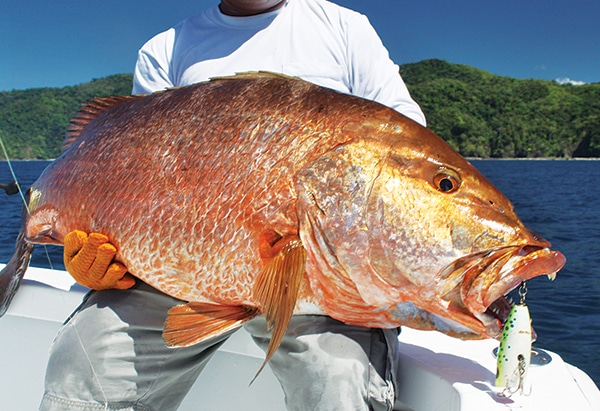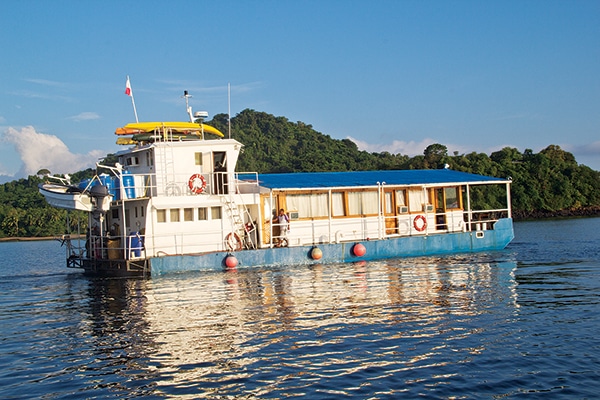
black marlin

Panama sunset

black marlin panama

black marlin fishing

tuna fishing panama

cubera snapper panama fishing

snook fishing panama

bluefin trevally panama fishing

dorado panama fishing

roosterfish panama fishing

african pompano panama fishing

Panama mothership charter

panama sunrise
“To Panama, where the fish are big and plentiful,” I shouted out to a gathering of predinner guests at the Panama Sport Fishing Lodge and was embraced by a loud cheer and the clanking of various glasses. Of course, a triumphant feeling already hung in the air as most of the anglers in the room had surpassed their personal big-fish goals after just a few days on the water. The stories got longer and louder as the evening progressed. I couldn’t help but contrast this group with the small clutches of mostly American anglers fishing here 20 years ago. Now, I found myself sitting next to a foursome from Russia and was later joined by anglers from Portugal, Greece, Indonesia and Argentina. The excited Argentineans would come by every few minutes to show me their digital shots and pretty much say the same thing: “Big fish, no?” Whether a marlin, tuna or roosterfish, if they thought it was big, it was big.
John de la Cruz’s Panama Sport Fishing Lodge, as with most lodges fishing the Gulf of Chiriquí, has attracted a fast-growing clientele from Asia, Europe and South America, as well as from the United States. The key has been not only the productive fishery amenable to a variety of fishing styles but also the development of a diverse variety of charter lodges, from motherships, island-based or traditional mainland facilities. The two common traits among the lodges are fast boats with skilled crews, a necessity to cover the often long distances in the gulf while pursuing pelagics, and the local knowledge required for near-shore fishing.
GULF GEOGRAPH****Y
The Republic of Panama stretches for 480 miles in an east-to-west orientation. On the Pacific coast, the Azuero Peninsula, a huge block of land, juts seaward for more than 40 miles, creating the Gulf of Panama on the east side and the Gulf of Chiriquí on the west. Isla de Coiba, the largest island in Central America, dominates Chiriquí, with the islands of Jicaron, Jicarita,
Montuosa, Ladrones, Parida, Secas and Contreras forming a circle of productive fishing habitat with the famous Hannibal Bank as the epicenter.
The continental shelf, here the 100-fathom line, meanders around the outskirts of the southerly islands. “I’ve been here more than 20 years, but nobody has really fished this gulf yet,” says Capt. Julian Jay Gustin, owner/operator of the mothership Pesca Panama (pescapanama.com). “Most fisheries start at the drop-off, but almost all the charters around here stop at Hannibal or other places short of the continental shelf. Someone needs to run far and explore all those deepwater seamounts shown on the charts.”
Oceanographers discovered a submerged cordillera ridge that links this area with the Galápagos and Cocos islands, creating a big-game highway. Additionally, the Chiriquí highland and its nearly 12,000-foot dormant volcano, Volcán Barú, protects the gulf from sustained winds, creating a very stable marine environment.
A reliable year-round fishery does preclude widespread exploration, especially when anglers are happy and fuel prices are high. Another Chiriquí veteran, Capt. Jim Wiese, a big-marlin specialist and owner of Cebaco Bay Sportfishing Club (cebacobay.com), says he has caught six grander marlin in this gulf.
“Unless you want blue marlin, it pays to stick to the shallows and high spots because that’s where the black marlin feed,” Wiese says. Targeting just one species can have its downside. “This past marlin season was slow by Panama standards,” he says. “There was probably an 80 percent drop reported by most of the boats fishing here, although there was plenty of bait, which is usually the key to good marlin fishing.”
During my last two trips in March and May 2013, I spent most of my time in pursuit of a variety of game fish, with just a few days set aside for billfish. Aboard Aguja, Wiese’s 56 Viking, we got three marlin strikes in two days but nothing to show for it. On the first day fishing with Capt. Carter Andrews, the fishing manager at Islas Secas Resort (islassecas.com), we hooked a 500-pound black marlin on Hannibal Bank, breaking the line after several jumps. At Capt. Dan Peavy’s Aqua Adventures sport-fishing lodge (hookedonpanama.com), my brother Armand, visiting Panama for the first time, released a 350-pound black marlin after it took a combination ballyhoo and small Mold Craft softhead lure near Islas Ladrones. There was also radio chatter of a flurry of marlin action at Montuosa. Slow marlin fishing in Panama is still probably better than most places.
TUNA, TUNA, TUN****A
Marlin may have put Panama on the map, but yellowfin tuna provide the biggest impact today. Every little detail, from the rods, reels, lures, style of boats, crew experience, as well as angler motivation, seems to have evolved to pursue these hard-fighting muscular torpedoes. Although available year-round, tuna exceeding 300 pounds seem to peak later in the season — from mid April to August. The dry season lasts from January to May, which is when most anglers choose to fish Panama. But that may change soon, since more lodges are staying open during the wet season.
“What we’ve seen in the last couple of years is huge schools of tuna and dolphin pushing green jacks to the surface and just exploding on them,” Wiese says. “It’s really exciting, and a popper’s paradise when that happens. They seem to be all over, as we’ve had schools right outside our anchorage at Cebaco Island within sight of the mothership. A few black marlin and sailfish also start showing up in water that’s barely 200 feet deep.”
Wiese’s “all over” is an understatement, as on any given day the tuna may be concentrated at reliable spots, such as Montuosa Island and Hannibal Bank or farther south at Jicaron and Jicarita islands. At times, there are fast-moving broken schools that seem to stretch to the horizon. Those skippers that have bird-detecting radar often have an advantage and can run to bird activity otherwise unseen. Capt. Shane Jarvis at Propiedad de Paradise (fishpanamatoday.com) goes one step further and lets competing lodge boats know where the birds are and doesn’t mind followers. He even shares live bait on occasion.
“I’m sort of the new guy from Florida, and I know my place among all these locals who grew up fishing here,” Jarvis says. “I like to give something back when I can, and it seems to be working.”
THE INSHORE FISHER****Y
After a few days of pulling on big tuna and marlin, many anglers need a change of pace and opt to try popping, jigging and live-bait trolling for the myriad inshore game fish that were originally the focus of Club Pacifico, one of the first fishing lodges in Panama. Built by Floridian Bob Griffin on Isla de Coiba with the use of prison camp labor from the infamous Coiba penal colony in the early ’70s, Club Pacifico used a fleet of 23-foot diesel Makos to work the rocky points and hazardous shoreline for roosterfish, cubera snapper, bluefin trevally, African pompano, black snook, wahoo, amberjack, rainbow runner, bigeye trevally and more.
On a trip in May, we released 26 species of fish mostly caught on poppers, which is not unusual for this gulf. Long-term investment in tourist facilities can be linked strongly to inshore fishing. Mark “Mr. C” Charman, a British expat currently residing in Dubai, United Arab Emirates, recognized that the quality of the inshore habitat coupled with the mystique of big game would last for years and aggressively invested $6 million in upgrading the Panama Big Game Fishing Club (panama-sportfishing.com). Additional first-class cabanas with private spas and pools are planned with new dockage for an expanded fleet of boats. Service is his driving force. “If you didn’t get everything you want, then you didn’t ask for it,” is a favorite quote.







